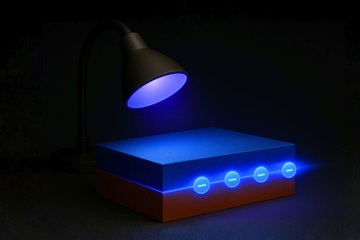Light switch for electrons
Researchers create conductive interface in nickelate materials

© David Sánchez Manzano (generated with AI)
UV light can be used to switch an extremely conductive state on and off at the interface between two oxide materials - in a matter of seconds. This newly discovered "light switch for electrons" marks a milestone on the way to light-controlled electronics and could also be used in superconductivity in the future. The journal Nature Materials reports. Part of the international team are Materials Chain member Prof. Dr. Rossitza Pentcheva (University of Duisburg-Essen) and her former colleague Dr. Benjamin Geisler (University of Florida).
"The highlight of our work is that an exceptionally conductive state can be switched on and off with light alone - almost like a switch," says Prof. Dr. Rossitza Pentcheva. "This also opens up new possibilities for specifically influencing superconductivity in nickelates in the future using ultrafast light pulses."
The study focuses on NdNiO₂, a representative of the so-called infinite-layer nickelates. This class of materials is similar to copper oxide high-temperature superconductors and has become increasingly important in recent years, as it can become superconducting itself under certain conditions.
Geisler and Pentcheva had already predicted in 2020 that a so-called two-dimensional electron gas could form at the interface between the nickelate NdNiO₂ and the insulator strontium titanate (SrTiO₃) - an extremely thin layer in which electrons move almost frictionlessly. Such states are considered key to future developments in nanoelectronics, spintronics and quantum information. In previous experiments, however, the electron gas failed to materialize because the atoms at the interface mixed more than expected - as an earlier joint study by the universities of Cornell, Stanford and Duisburg-Essen had already shown in Nature Materials in 2023.
Now, the international research team specifically used light as a stimulus: in the experiments, they irradiated the interface with ultraviolet light and simultaneously measured the electrical conductivity. At the same time, Geisler and Pentcheva carried out quantum mechanical simulations on the UDE supercomputer, which allowed them to precisely describe the behavior of the electrons.
"When the light is switched on, the material changes abruptly: the electrical resistance drops by up to a hundred thousand times - the sample suddenly conducts around 100,000 times better," explains Pentcheva. This is made possible by a tiny electric field at the interface, which collects the electrons released by UV light in a wafer-thin layer as if on an invisible track. There they can move particularly easily and form the conductive electron gas. As soon as the light is switched off, this state disappears completely - the material returns to its original state.
About the publication:
Sanchez-Manzano, D., Krieger, G., Raji, A. et al. Giant photoconductance at infinite-layer nickelate/SrTiO3 interfaces via an optically induced high-mobility electron gas. Nat. Mater. (2025). doi: 10.1038/s41563-025-02363-y
https://www.uni-due.de/cenide/en/news-detail.php?id=light-switch-for-electrons
